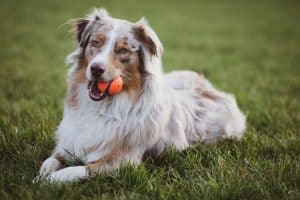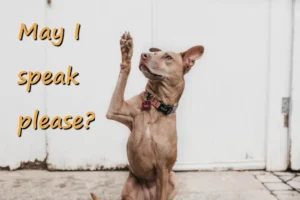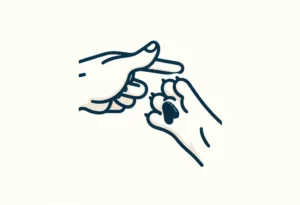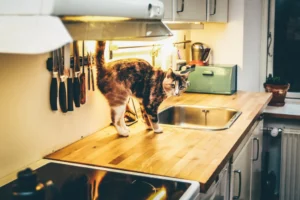There’s nothing quite like the heart-stopping moment when your furry best friend darts off after a squirrel, heedless of your frantic calls. Teaching Fido to wait can mean the difference between a peaceful walk and a neighborhood chase scene.
By the end of this post, you’ll have a step-by-step strategy to teach your dog the art of ‘wait’, transforming your hasty hound into a patient pooch.
Key takeaways:
- ‘Wait’ teaches your dog to pause on cue, enhancing safety during walks and daily routines.
- Combine a clear verbal command with an outstretched palm and reward immediately to reinforce the ‘wait’.
- Avoid common training mistakes by ensuring consistency, appropriate reward timing, and adjusting to your dog’s energy levels.
Why Is Teaching ‘Wait’ So Important?
Teaching your furry friend the ‘wait’ command is as much about safety as it is about manners. It’s the difference between a peaceful walk and a heart-stopping moment when your pup darts into the street. Imagine standing at a busy intersection; your dog knows ‘wait,’ and despite the buzzing distractions, they pause by your side. That’s a sigh of relief right there.
Or picture this: You’re unloading groceries from the car, and your canine companion patiently ‘waits’ rather than bounding out into the driveway. In the kitchen, ‘wait’ keeps curious noses away from hot stoves or sharp knives during meal prep. It’s a simple word that can prevent accidents and create a harmonious living environment.
What’s the Difference Between ‘Wait’ and ‘Stay’?
Let’s clear up some misconceptions. ‘Wait’ is akin to putting a video on pause — anticipate hitting play very soon. It means, “Hold on, buddy, we’re almost good to go.” On the other hand, ‘stay’ is like saving your show to watch another day. It translates to, “Sit tight, I’ll be back, but it could be a while.”
This distinction is crucial. Dogs thrive on clear, consistent communication. When they learn the specifics of ‘wait’ versus ‘stay,’ they gain a better understanding of what’s expected, which in turn leads to better responses to your commands.
Where Should You Start With ‘Wait’ Training?
Ready to lay the foundation? Here’s how:
-
Pick Your Spot : Find a quiet place free from distractions where you and your pup can focus on each other.
-
Short but Sweet : Begin with short ‘wait’ periods. Even a few seconds is a win!
-
Gradual Build-Up : As your dog nails the short waits, incrementally extend the time.
Step-by-Step Guide :
- Prep Talk: Let your dog know it’s training time. A happy voice can set the mood.
- The Cue: Start with your dog on a leash for better control. Use a hand signal — like an outstretched palm — alongside the verbal cue “wait.”
- The Reward: At first, promptly reward them with treats or praise after a short ‘wait.’ This positive reinforcement goes a long way.
- Practice Makes Perfect: Repeat the process regularly, slowly upping the ante with longer waits or more challenging environments.
Here’s a golden nugget: Transition from treats to life rewards. Instead of a treat, open the door as a reward for waiting, or begin their walk. This creates real-world applications for ‘wait’ and keeps your dog keen on the command without always expecting a snack.
There you have it—your starting line for teaching ‘wait.’ Stick around as this journey is just unfurling, and by staying the course, you’ll be well on your way to molding a patient and attentive companion.
How Can You Use Treats Effectively?
When it comes to training your furry friend, treats are the ace up your sleeve. But it’s not just about giving treats; it’s about when and how you give them that turns them into a powerful training tool.
First up, timing is everything. The moment your dog follows your ‘wait’ command, reward them immediately. Dogs live in the now, so even a few seconds delay can confuse the association between their action and the reward. It’s like snapping a picture at the perfect moment – you’ve got to be quick to capture it.
Now, onto the type of treats. Think of treats as currency – the yummier the treat, the higher its value. Use high-value treats for new or challenging tricks like ‘wait’, because you want Max to think, “Wow, waiting gets me that? I’m in!” These could be small pieces of chicken or cheese – something that stands out from their everyday kibble.
But here’s the kicker – if you keep doling out treats like there’s no tomorrow, Max might only listen when there’s a treat in sight. So, once he’s got the hang of it, start to mix it up. Give him a treat sometimes, other times praise or a favorite toy. Then gradually fade the treats out. Call it treat tapering. You’re aiming for Max to ‘wait’ because he respects you, not just for the goodies.
Quick Tips for Using Treats:
– Use special treats for new commands.
– Reward instantly for successful ‘wait’.
– Gradually reduce treat frequency as your dog gets the hang of it.
Remember, it’s not about phasing out rewards altogether, but about diversifying them. Praise, play, and physical affection can also be powerful motivators. The goal is to make obedience its own reward.
What Are the Common Mistakes to Avoid?
Alright, it’s truth time. Training your pup to ‘wait’ is like teaching a kid to ride a bike – you’ve got to expect a few wobbles. But being aware of the common trip-ups can keep you on the straight and narrow.
Inconsistency is a big no-no. If “wait” means “pause here” today and “come here” tomorrow, you’ll end up with a confused pooch. Pick one meaning, one gesture, and stick to it like glue. Consistency is king.
Next is poor timing with rewards or corrections. If you muddle up your timing, rewarding too late or correcting after the fact, you’ll send mixed messages. It’s akin to laughing at a joke minutes after the punchline – the moment’s lost.
And here’s a common oversight: Remember to tailor the difficulty of the task to your dog’s mood and energy level. If Buddy’s bouncing off the walls, asking him to ‘wait’ might be setting him up for failure. Energy management is part of smart training.
Here’s one unique tip you won’t hear often: Use your dog’s name positively. Instead of scolding “Buddy, wait!” with a harsh tone, try a cheerful “Buddy, wait!” and reward him when he does. You always want Buddy to have positive associations with his name and your commands.
Training Pitfalls to Dodge:
– Inconsistent commands or signals.
– Rewarding or correcting too late.
– Not matching the difficulty level to your dog’s current state.
– Using your dog’s name in a negative context.
There’s no one-size-fits-all in dog training, but sidestepping these mistakes puts you on the path to a well-trained companion.
In the end, it’s all about being patient, perceptive, and progressive. Keep it friendly and fun, and you’ll find that ‘wait’ will become second nature to your canine pal. And isn’t the vision of your dog calmly pausing on command worth the effort? You bet it is!
Alex, a passionate animal lover, has experience in training and understanding animal behavior. As a proud pet parent to two dogs and three cats, he founded AnimalReport.net to share insights from animal experts and expand his knowledge of the animal kingdom.










